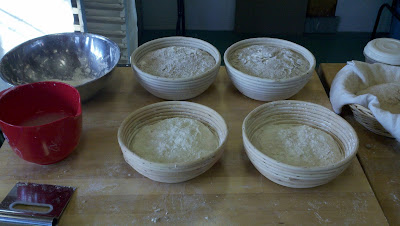I learned quite a bit in the day and a half and it was very helpful to see a baker kneading, shaping and scoring loaves. One of the most important things I took away from the class was the importance of maintaining a temperature range of 70-75 degrees when refreshing your starter and fermenting your dough. I believe that many of my sub-standard loaves at home have been caused by fermenting at too low a temperature or using a less than fully active starter.
My loaves proofing in the classroom.
Everyone brought their loaves out to the oven.
Derek loading loaves into the oven.
Derek testing loaves for doneness.
The beautiful rustic loaves.







